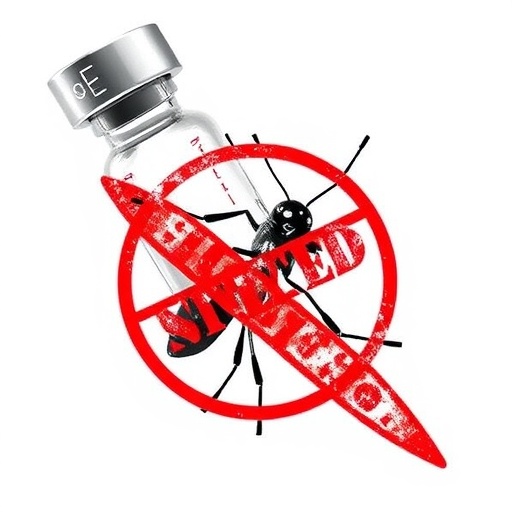In a significant development within the field of infectious disease prevention, leading experts have recommended a temporary halt on the deployment of a live attenuated chikungunya virus vaccine, as detailed in a recently discussed viewpoint by Dr. Vinay Prasad and colleagues at the U.S. Food and Drug Administration’s Center for Biologics Evaluation and Research. This decision arises amid mounting safety concerns that have emerged from ongoing evaluations of the vaccine’s risk profile, underscoring the inherent challenges encountered when harnessing live attenuated viral platforms for immunization against arboviral diseases.
The chikungunya virus, an arthropod-borne alphavirus transmitted primarily through Aedes mosquitoes, has been the focus of intense vaccine development efforts due to its rapid geographic expansion and the debilitating polyarthralgia it causes in infected individuals. Historically, vaccine candidates using live attenuated virus approaches have demonstrated robust immunogenicity, eliciting durable neutralizing antibody responses and cellular immunity. However, the utilization of replication-competent viral strains carries intrinsic safety risks, notably the potential for adverse events linked to residual virulence or reversion to a pathogenic phenotype.
Dr. Prasad’s viewpoint articulates that recent post-licensure surveillance and clinical trial data reveal safety signals that necessitate immediate attention. These signals vključujejo instances of unexpected immunopathological reactions and, in rare cases, vaccine-associated persistent arthritic symptoms akin to the disease the vaccine aims to prevent. The safety communication advocates for a pause to facilitate comprehensive risk-benefit analyses, enhanced pharmacovigilance measures, and further mechanistic studies to delineate the underpinnings of these adverse outcomes.
Crucially, this pause highlights the delicate balance between vaccine efficacy and safety, particularly when dealing with live attenuated vaccines for viruses capable of establishing prolonged or atypical infections. These challenges call for rigorous scrutiny of viral attenuation strategies, including genomic stabilization, targeted mutagenesis, and the incorporation of safety switches to preempt unintended consequences. The chikungunya vaccine case exemplifies why more conservative approaches, such as non-replicating viral vectors or subunit vaccines, may warrant consideration despite potentially lower immunogenicity.
The Food and Drug Administration’s proactive communication aims to alert clinicians, public health officials, and vaccine developers to recalibrate the deployment strategy for this chikungunya vaccine. Transparent disclosure of emerging risks fosters trust and facilitates informed decision-making, especially in the context of public health emergencies where rapid vaccine availability is weighed against safety uncertainties. It also emphasizes the criticality of tailored post-market surveillance systems designed to promptly identify and investigate adverse events, thus safeguarding population health.
From an immunological standpoint, live attenuated vaccines closely mimic natural infection, engaging multiple arms of the immune system, which typically results in robust and durable protection. Yet, the risk that attenuated strains might retain or reacquire pathogenic traits remains a persistent hurdle. The chikungunya vaccine’s safety profile underscores the importance of mapping viral mutations associated with attenuation and monitoring for genetic stability throughout vaccine production and administration cycles.
Furthermore, this development prompts reevaluation of current regulatory frameworks governing live attenuated vaccines. Enhanced guidelines emphasizing genetic characterization, stability testing, and long-term follow-up could mitigate risks in future vaccine candidates. Simultaneously, this pause invites the scientific community to revisit adjunctive approaches such as adjuvant optimization and delivery platforms that might obviate the need for live attenuated formulations.
In the broader context of arboviral vaccine research, the chikungunya vaccine safety communication serves as a pivotal reminder of complexities in combating emerging vector-borne diseases. It encourages a multidisciplinary approach involving virology, immunology, epidemiology, and regulatory science to innovate safer and equally efficacious vaccine modalities. The insights gained could also translate to other related pathogens, including dengue, Zika, and Mayaro viruses, facilitating holistic progress in tropical infectious disease control.
Lastly, public perception and media coverage will play instrumental roles during this interim pause, necessitating clear and consistent messaging from health authorities. Effective communication strategies must balance urgency with caution, ensuring that public confidence in vaccination programs is maintained without undermining vigilance. The chikungunya vaccine experience highlights the continual evolution of vaccine science and the imperatives of adaptive policies in dynamically confronting infectious threats.
In conclusion, the FDA-led safety communication advocating a pause on the live attenuated chikungunya virus vaccine underscores a critical juncture in vaccine development. It shines a light on the nuanced interplay between immunogenic potency and safety risks inherent to live attenuated viral vaccines, especially for emerging pathogens. This methodical reassessment period is poised to inform future innovations, regulatory practices, and public health strategies aimed at eliminating the burden of chikungunya and similar viral diseases worldwide.
Subject of Research: Safety evaluation and regulatory considerations for live attenuated chikungunya virus vaccines.
Article Title: Safety Communication Recommending a Pause in Live Attenuated Chikungunya Virus Vaccine Use.
News Publication Date: Not specified.
Web References: Not provided.
References: (doi:10.1001/jama.2025.9393)
Keywords: Live attenuated vaccines, chikungunya virus, vaccine safety, arboviral diseases, immunogenicity, vaccine pause, FDA safety communication, viral attenuation, infectious disease prevention, vaccine pharmacovigilance.




